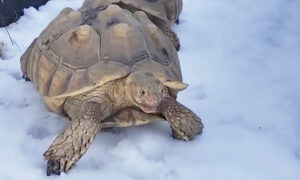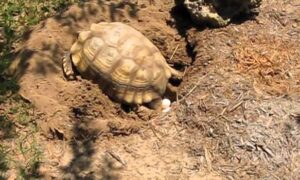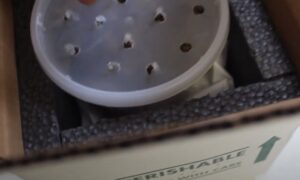Many people let their sulcata tortoise roam the house. They believe it’s a good form of exercise and a means to explore. Other tortoise keepers who let their tortoise roam the house may use their home as an indoor tortoise enclosure instead of a safe, and proper, outdoor enclosure.
But, there are dangers of letting your sulcata tortoise roam the house.
Eat Inappropriate Objects
Tortoises are curious creatures, and much like how curiosity killed the cat, it can get your tortoise too. Sulcata tortoises will try to eat anything, so if it’s on the floor or within reach, it may become a snack.
Your tortoise may get ahold of jewelry that has fallen, dust bunnies, wires, plastic pieces, plush animals, random food scraps, other pet’s food, rat poison, roach traps, etc.
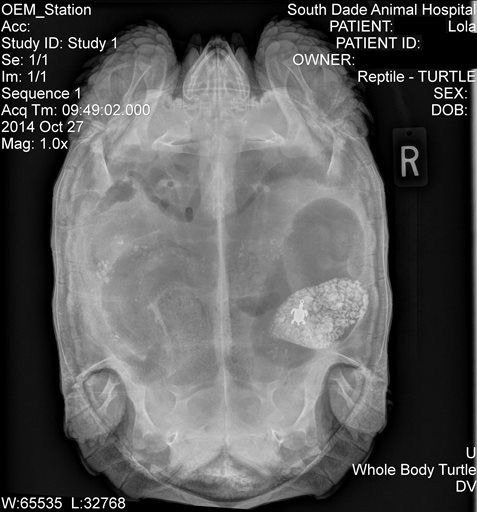
It’s Too Cold on the Floor
Tortoises are cold blooded animals. They need external heat sources. If you let a sulcata tortoise roam the house, you’re taking away the ability to bask. Even if you set up a heat source, like a basking bulb, you’ll find it rather hard to actually provide a sufficient amount of heat. Most of the heat will likely cool before reaching your tortoise.
Even if you leave your house on the warmer side, the floor is still going to be colder.
Not Enough UVB
Leaving your tortoise in the house doesn’t help the need for UVB. Keep in mind that just because you have a window, your tortoise isn’t absorbing any of the UV.
If you have a UV bulb set up, keep in mind it needs to be set up low enough for the tortoise to actually get any UV.
Hard on Their Legs and Joints
Large sulcata tortoises cannot walk well on tile or hardwood floor. They have to sprawl their legs out to walk on any smooth surface. If they have to walk like this for long periods of time, you risk permanent damage. This can not only affect your tortoise’s bones, but his muscles.
If you have carpeted floors, you’ll find that your tortoise can walk on it better. But, you may also notice that his nails can easily get caught in the carpet.
Increase the Risk of Spreading Salmonella
Sulcata tortoises, like most reptiles, carry salmonella, which is a bacteria that can cause fever, diarrhea, vomiting, nausea and headaches. Salmonella can last two to seven days.
The bacteria is carried on the tortoise’s skin and shell and within the digestive tract. If the tortoise is left to free roam the house, it can poop and pee wherever it pleases, and it can be hard to potty train a sulcata. The tortoise can touch anything within reach. The spread of the salmonella bacteria can be anywhere, putting you and your family at risk.
Property Damage
Large sulcata tortoises are prone to damaging your property. They can dig through the walls or flooring. Chew wires, furniture, etc.
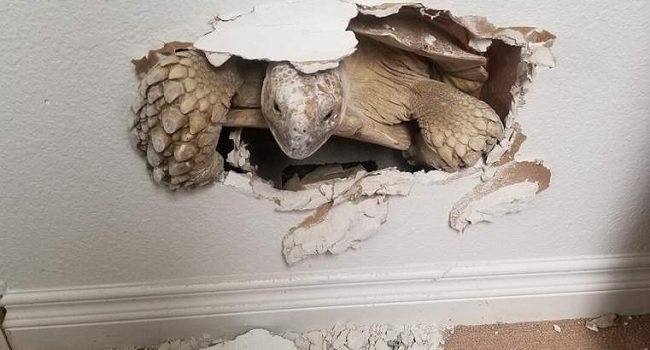
Other Dangers for a House Tortoise
- Sharp Objects – whether it be sharp angles on a wall, decorative items, fireplaces, etc, tortoises can get hurt. Sharp items can fall on a large sulcata that’s banging against a table. A running child could knock something over onto your tortoise, or break a glass that your tortoise steps on or eats.
- Floor Heaters – If your home has a floor heater, your tortoise could try to “snuggle” up against it, burning himself. The tortoise can get its nails caught in the vents.
- Other Pets – If you have dogs, cats, birds or other pets inside your home, they pose a danger risk to your sulcata tortoise.
- Get Lost – If your tortoise is on the medium size, he could get lost in the house… Even if your tortoise is a large sulcata, he could still find a place that is well hidden. You would likely find a larger tortoise, but the smaller the tortoise, the more risky it is to let it roam.
Supervision is the Key
If you’re going to let your sulcata roam the house, you want to supervise it at all times. Needless to say… It’s not safe to let your tortoise roam the house because you just can’t watch it at all hours of the day.
If you have a room specifically designed JUST for your tortoise, don’t let it roam the house. A secure and safe enclosure is the best way to care for your sulcata.
Why Would I Want My Tortoise to Free Roam My House?
Cold Winters
If you can’t house your sulcata outside during the winter, you will want to find an alternative housing option that’s not free roaming your house. If the weather outside is too cold, build an insulated dog house for your tortoise to stay warm.
Enclosure Isn’t Big Enough
Sorry, but you should have thought about what you were going to do with a large sulcata when you bought the cute, tiny baby sulcata.

